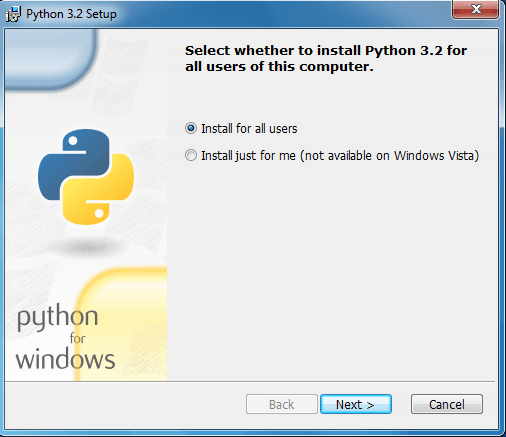Hi all,
The PYTHON is a programming language. Python is a general-purpose interpreted, object-oriented, interactive, and high-level programming language.
The python language was created by Guido van Rossum during 1985- 1990.
- Python is Interpreted: The PYTHON is an interpreted language. And it is processed at runtime by the interpreter. You can’t compile your program before executing it.
-
Python is Object-Oriented: The PYTHON language support object oriented styles.
PYTHON language structure supports various concepts such as: multiple inheritance,operation overloading and polymorphism. - Python is Interactive:Python prompt and interact with the interpreter directly to write your programs.
- Python is a Beginner’s Language: Python is a great language for the beginner-level programmers and supports the development of a wide range of applications from simple text processing to WWW browsers to games.
Why PYTHON
- It’s simple language.
- It’s procedural language
- It’s object oriented and interpreted language.
Python Features
- Open source programming language
- Easy to learn: It’s clear and easy syntax. Its simple structure and clearly defined syntax.
- Easy to read
- Easy to maintain: The source code of python is fairly easy-to-maintain.
- Portable: Python is portable and can be used on Windows, Linux, Solaris, Macintosh, Amiga, FreeBSD, OS/2, AROS, AS/400 and many more.Python can run on a wide variety of hardware platforms.
- Extendable
- GUI Programming
- It support high level programming language.
Install Python 3.2 on Windows 7/ Windows 8 / Windows 10
Download .msi file of Python from http://www.python.org/getit/releases/3.2/. Once downloaded, double click the file to install Python 3.2 on Windows 7.
Start Installation

Select Installation folder

Wait now till the installation process is finished.

Click Finish button at this stage abd that’s it. You may open Python command line form Start Menu and you may run python commands as shown bellow:

Simple example
>>> print "Welcome To Python!"
OR
>>> print("Welcome To Python!")
The output will be:
Welcome To Python!
It’s very easy to develope python script.
If anyone has doubts on this topic then please do let me know by leaving comments or send me an email.




how to get clomiphene pill how to get generic clomid no prescription order clomid for sale how can i get generic clomid buy cheap clomiphene where can i get generic clomid no prescription where can i buy clomiphene without dr prescription
70918248
References:
why would a doctor prescribe steroids [http://www.bzsbs.cn/home.php?mod=space&uid=142089]
Benefits Of Napping After A Workout
Benefits Of Napping After A Workout
That feel-good feeling after exercise is often attributed to endorphins released
during physical activity. However, did you know that napping
after a workout can amplify these benefits and provide additional health advantages?
What Happens to Your Body After a Workout
Your body undergoes significant changes when you exercise,
from increased heart rate to muscle tissue repair.
Overexertion can lead to fatigue, making it essential to rest and recover properly.
How Your Body Temperature Contributes to Napping
Exercise generates body heat, which can help regulate your internal temperature
during sleep. A cooler core temperature may improve sleep quality and
recovery.
Exercise-Induced Fatigue: The Flip Side of Feeling Good
While the immediate post-exercise endorphins make you feel
invigorated, prolonged fatigue can set in without
adequate rest. Napping can help combat this weariness.
Muscle Recovery
Napping after a workout promotes muscle recovery
by allowing your body to repair and grow muscles faster.
This is crucial for enhancing strength and performance over time.
Improved Cognitive Function
Resting your body through napping can improve cognitive functions like memory and focus, especially important if you’re aiming to stay sharp and productive throughout the day.
Boosted Immune System
Adequate sleep supports a healthy immune system. Regular
napping after workouts helps maintain this balance, reducing your susceptibility
to illness or infection.
Enhanced Mood and Mental Well-Being
Napping can uplift your mood and improve mental health by regulating stress hormones
like cortisol. This can lead to a more balanced emotional state.
Better Overall Performance
With improved recovery, muscle function, and cognitive focus, napping after exercise can enhance your physical performance in subsequent workouts and daily activities.
Timing is Everything: When to Nap After a Workout
The ideal time to nap varies based on factors like workout intensity and personal sleep patterns.
Typically, a short nap (20-30 minutes) is beneficial for recovery without causing grogginess.
What Is the Ideal Nap Duration?
Avoid napping too long, as it can lead to oversleeping and
interfere with your circadian rhythm. A 90-minute nap might seem ideal, but a shorter duration often suffices for recovery benefits
without unwanted side effects.
Can You Nap After Every Workout?
Napping after every workout isn’t necessary unless you’re
extremely active or have demanding physical goals. Adjusting your napping schedule based on your lifestyle and sleep needs is key to avoiding burnout.
Tips for Effective Post-Workout Napping
• Create a quiet, comfortable environment to ensure restful sleep.
• Set an alarm to prevent oversleeping.
• Hydrate before napping to aid in recovery.
• Eat a light meal beforehand to avoid feeling too hungry
while resting.
• Avoid caffeine or stimulants close to nap time to maintain relaxation.
• Listen to your body’s signals and adjust your napping routine as
needed.
Posts by Ben Drew
Does It Matter What Age You Start Running?
How To Run a 5k with a Couch to 5k Training Plan
Related Posts
Why Do I Taste Blood When I Run? Causes, Treatments, and
Prevention
How to Treat and Prevent Sore Calves From Running
Why Do My Fingers Swell When I Walk or Run? Tips and Prevention
Stay Connected
Also visit my site best steroid to lose belly fat
Okay.. 🙂
After installing Python3 , we can’t say print “Hello” , Syntax changed from py 2 to p3 .
you suppose to use print(“Hello”)